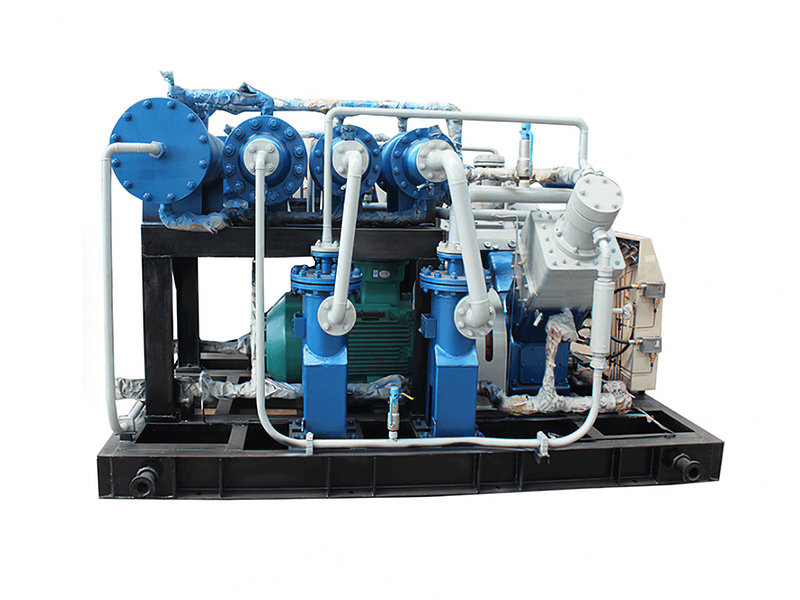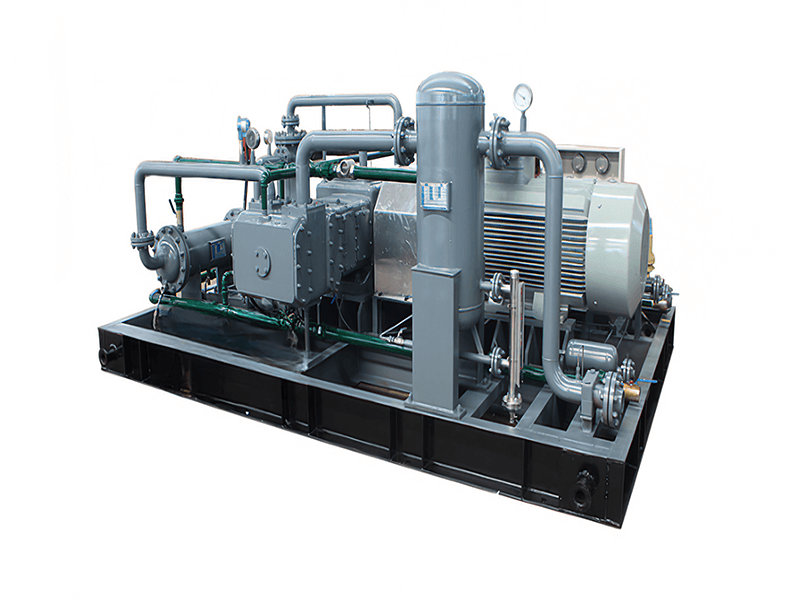A hydrogen compressor is a specialized device used to increase the pressure of hydrogen gas. It takes in hydrogen gas at a lower pressure and compresses it to a higher pressure, enabling its storage, transportation, or utilization in various applications. Hydrogen compressors play a crucial role in industries and processes where high-pressure hydrogen is required.
Hydrogen compressors are designed to handle the unique properties of hydrogen gas, such as its low molecular weight and high diffusivity. They ensure efficient compression while minimizing hydrogen losses and maintaining safety. Depending on the specific application and requirements, different types of hydrogen compressors may be used, including reciprocating compressors and rotary compressors.
Reciprocating compressors use pistons that move back and forth within cylinders to compress the hydrogen gas. The pistons draw in hydrogen gas during the suction stroke and then compress it during the compression stroke. Reciprocating compressors are known for their high efficiency and ability to handle a wide range of pressures.
Rotary compressors, such as screw compressors or vane compressors, use rotating mechanisms to compress the hydrogen gas. These compressors trap the hydrogen gas between rotating elements or lobes, compressing it as the rotors turn. Rotary compressors are often used for continuous compression applications and can provide high flow rates.
Hydrogen compressors are typically composed of various components, including a compressor housing, inlet and outlet ports, compression chambers, pistons or rotors, crankshafts or drive shafts, valves, seals, lubrication systems, cooling systems, and control and safety devices. These components work together to facilitate the compression process and ensure efficient and safe operation.
The compressed hydrogen gas produced by the hydrogen compressor can be used for a wide range of applications, including hydrogen fueling stations for fuel cell vehicles, industrial processes, hydrogen storage, chemical production, and research and development activities.
Components of a hydrogen compressor
Hydrogen compressors are specialized equipment designed to handle and compress hydrogen gas. They typically consist of several key components that work together to facilitate the compression process. Here are the main components of a hydrogen compressor:
1. Compressor Housing: The compressor housing is the outer casing that encloses the internal components of the hydrogen compressor. It provides structural support and protects the internal components from external elements.
2. Inlet and Outlet Ports: These ports serve as the entry and exit points for the hydrogen gas. The inlet port allows the gas to enter the compressor, while the outlet port releases the compressed hydrogen gas.
3. Compression Chamber: The compression chamber is where the actual compression of the hydrogen gas takes place. It is a sealed space where the gas is compressed by the movement of the compressor's internal components.
4. Pistons or Rotors: Hydrogen compressors can utilize either pistons or rotors as the primary compression mechanism. Pistons move back and forth within cylinders, compressing the gas, while rotors rotate and trap the gas between their lobes, compressing it as they turn.
5. Crankshaft or Drive Shaft: The crankshaft or drive shaft is responsible for converting the rotary motion generated by an electric motor or other power source into the reciprocating motion required by piston-based compressors. It transfers the rotational energy to the pistons or rotors for compression.
6. Valves: Hydrogen compressors have intake and discharge valves that control the flow of gas into and out of the compression chamber. These valves open and close at specific times to allow the gas to enter, be compressed, and then exit the compression chamber.
7. Seals and Gaskets: Seals and gaskets are crucial components that help maintain the integrity of the compression chamber, preventing gas leakage. They ensure a tight seal between moving parts and stationary components, minimizing losses and maintaining efficiency.
8. Cooling System: Hydrogen compression generates heat, so compressors often incorporate a cooling system to dissipate excess heat and maintain optimal operating temperatures. This may involve the use of cooling fins, heat exchangers, or a dedicated cooling medium to prevent overheating.
9. Lubrication System: Compressors require lubrication to minimize friction and wear between moving parts. A lubrication system, such as oil circulation, ensures smooth operation and prolongs the life of the compressor components.
10. Control and Safety Devices: Hydrogen compressors are equipped with various control and safety devices to monitor and manage the compressor's operation. These may include pressure sensors, temperature sensors, safety valves, and control panels for adjusting compression parameters and ensuring safe and efficient operation.
11. Gas Purification System: Hydrogen compressors used in applications requiring high-purity hydrogen often incorporate gas purification systems. These systems remove impurities, such as moisture, oxygen, and trace contaminants, from the hydrogen gas before it enters the compression chamber. This ensures the production of clean and pure compressed hydrogen.
12. Pressure Relief Devices: To ensure safe operation, hydrogen compressors are equipped with pressure relief devices, such as relief valves or rupture discs. These devices are designed to release excess pressure in the system to prevent overpressurization.
13. Intercoolers or Aftercoolers: Intercoolers or aftercoolers are heat exchangers that cool the compressed hydrogen gas between stages of compression or after the compression process. Cooling the gas helps reduce its temperature and improve the overall efficiency of the compressor.
14. Control System: Hydrogen compressors incorporate control systems that monitor and regulate various parameters, such as pressure, temperature, and flow rate. The control system ensures that the compressor operates within safe limits and optimizes performance.
15. Drive System: The drive system of a hydrogen compressor provides the power to operate the compressor. It can be an electric motor, a gas engine, or another power source depending on the specific application and requirements.
16. Instrumentation and Sensors: Hydrogen compressors may include instrumentation and sensors to provide real-time monitoring and feedback on crucial parameters, such as pressure, temperature, vibration, and oil condition. This information helps operators monitor the compressor's performance and detect any anomalies or potential issues.
17. Noise Reduction Features: Some hydrogen compressors incorporate noise reduction features to minimize the noise generated during operation. This can include sound-damping materials, vibration isolators, or enclosures designed to reduce noise levels and create a quieter working environment.
18. Remote Monitoring and Control: In certain applications, hydrogen compressors may be equipped with remote monitoring and control capabilities. This allows operators to monitor and control the compressor's operation from a central control room or through a connected system, enhancing efficiency and convenience.
19. Maintenance and Serviceability Features: Hydrogen compressors often include features that facilitate maintenance and service activities. This can include easy access to components for inspection and maintenance, built-in diagnostics systems, and modular designs that allow for quick replacement or repair of parts.
20. Safety Systems: Hydrogen compressors prioritize safety and may incorporate additional safety systems, such as gas leak detection devices, flame arrestors, or explosion-proof designs. These features help mitigate potential risks associated with handling hydrogen gas.
These are the main components typically found in hydrogen compressors. The specific design and configuration of a hydrogen compressor may vary depending on the type of compressor (e.g., reciprocating, rotary), capacity, and intended application.
Maintenance of hydrogen compressor
Maintenance of a hydrogen compressor is crucial to ensure its proper functioning, reliability, and longevity. Regular maintenance helps identify and address potential issues before they escalate into more significant problems. Here are some key maintenance practices for hydrogen compressors:
1. Regular Inspections: Conduct routine visual inspections of the compressor to check for any signs of wear, leaks, loose components, or abnormal conditions. Pay attention to areas such as seals, gaskets, valves, and fittings.
2. Lubrication: Follow the manufacturer's guidelines for lubrication requirements. Regularly lubricate the compressor's moving parts, such as pistons, rotors, and bearings, to minimize friction and wear. Ensure the use of appropriate lubricants suitable for hydrogen service.
3. Filter Replacement: Replace or clean filters as recommended by the manufacturer to prevent contaminants from entering the compressor and affecting its performance. This includes intake filters, oil filters, and any other filtration systems in place.
4. Cooling System Maintenance: If the compressor has a cooling system, inspect and clean cooling fins, heat exchangers, or other cooling components regularly. Ensure proper airflow and cooling efficiency to prevent overheating.
5. Gas Purification System Maintenance: If the hydrogen compressor incorporates a gas purification system, follow the manufacturer's instructions for maintenance. This may involve periodic replacement or regeneration of purification media, such as desiccants or catalysts.
6. Tightening and Alignment: Check and tighten any loose bolts, nuts, or fasteners. Ensure proper alignment of components, such as pistons, rods, and valves, to avoid excessive vibrations or misalignment issues.
7. Pressure Relief Device Inspection: Regularly inspect and test pressure relief devices, such as relief valves or rupture discs, to ensure they are in proper working condition. Verify that they are set to the correct pressure limits and replace any faulty or expired devices.
8. Control System Calibration: Calibrate and test the control system periodically to ensure accurate monitoring and control of the compressor's parameters. This includes pressure sensors, temperature sensors, and any other instrumentation or control devices.
9. Safety System Testing: Test and verify the functionality of safety systems, such as gas leak detection devices or flame arrestors, as per manufacturer recommendations. Replace or repair any faulty safety components.
10. Record Keeping: Maintain detailed records of maintenance activities, including inspection dates, component replacements, repairs, and any abnormalities observed. This helps track the compressor's maintenance history and aids in troubleshooting or future maintenance planning.
11. Manufacturer Guidelines: Always refer to the manufacturer's maintenance guidelines and recommendations specific to the hydrogen compressor model being used. Follow their instructions related to maintenance intervals, specific maintenance tasks, and any unique requirements.
12. Training and Expertise: Ensure that maintenance personnel are adequately trained in handling and maintaining hydrogen compressors. They should be familiar with safety protocols, proper procedures, and any specific considerations associated with working with hydrogen gas.
13. Vibration Analysis: Perform regular vibration analysis on the compressor to detect any excessive vibration levels. Excessive vibration can indicate issues with components, alignment problems, or imbalance, which should be addressed promptly to prevent further damage.
14. Belt and Drive System Maintenance: If the compressor utilizes belts or a drive system, inspect and adjust them as needed. Check for proper tension, alignment, and wear. Replace worn-out belts or damaged drive components to maintain efficient operation.
15. Valve Maintenance: Regularly inspect and maintain the valves in the compressor, including intake and discharge valves. Clean or replace valves that show signs of wear, leakage, or reduced performance. Ensure proper sealing and smooth operation of the valve mechanisms.
16. Leak Detection and Repair: Conduct regular leak detection inspections using appropriate techniques, such as hydrogen leak detectors or other approved methods. Promptly repair any identified leaks to prevent hydrogen loss, ensure system efficiency, and maintain safety.
17. Electrical System Inspection: Inspect the electrical components of the compressor, including wiring, connectors, and control panels. Check for signs of damage, loose connections, or abnormal electrical behaviors. Address any electrical issues to avoid malfunctions or safety hazards.
18. Compressor Cleaning: Clean the compressor regularly to remove dirt, debris, or contaminants that may accumulate on the exterior or interior surfaces. Follow the manufacturer's guidelines for cleaning procedures and use appropriate cleaning agents to prevent damage to sensitive components.
19. Performance Monitoring: Monitor and log the performance parameters of the compressor, such as pressure, temperature, flow rate, and power consumption. Establish baseline performance data and compare it with ongoing measurements to identify any deviations, which may indicate potential issues requiring attention.
20. Training and Knowledge Sharing: Continuously train maintenance personnel on hydrogen compressor maintenance best practices, safety protocols, and industry updates. Foster knowledge sharing within the maintenance team to leverage collective expertise and ensure consistent and effective maintenance practices.
21. Compliance with Regulations and Standards: Comply with applicable regulations, codes, and industry standards related to hydrogen compressor maintenance. Stay updated with any changes in safety guidelines, preventive maintenance schedules, or recommended practices specific to hydrogen handling and compression.
22. Emergency Preparedness: Establish emergency response plans and procedures in case of compressor failures, leaks, or other emergencies. Ensure that personnel are familiar with these procedures and have access to safety equipment, such as personal protective equipment (PPE), hydrogen detectors, and emergency shutdown systems.
By following these maintenance practices, you can help ensure the reliable and safe operation of hydrogen compressors. Regular maintenance, inspections, and proactive troubleshooting will aid in identifying and addressing potential issues early on, minimizing downtime and optimizing the performance of the hydrogen compressor.

























